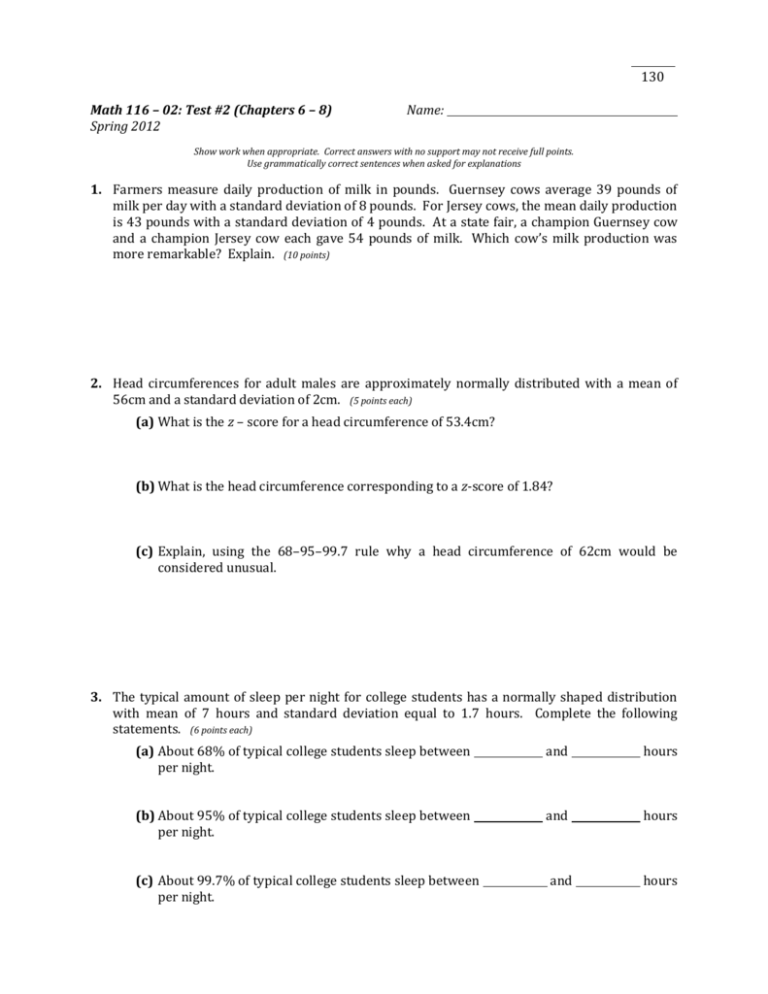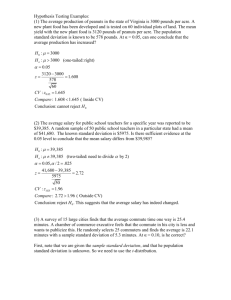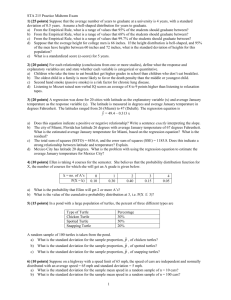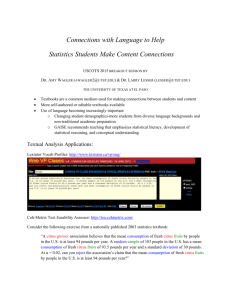116Test2_S12
advertisement

130 Math 116 – 02: Test #2 (Chapters 6 – 8) Spring 2012 Name: Show work when appropriate. Correct answers with no support may not receive full points. Use grammatically correct sentences when asked for explanations 1. Farmers measure daily production of milk in pounds. Guernsey cows average 39 pounds of milk per day with a standard deviation of 8 pounds. For Jersey cows, the mean daily production is 43 pounds with a standard deviation of 4 pounds. At a state fair, a champion Guernsey cow and a champion Jersey cow each gave 54 pounds of milk. Which cow’s milk production was more remarkable? Explain. (10 points) 2. Head circumferences for adult males are approximately normally distributed with a mean of 56cm and a standard deviation of 2cm. (5 points each) (a) What is the z – score for a head circumference of 53.4cm? (b) What is the head circumference corresponding to a z-score of 1.84? (c) Explain, using the 68–95–99.7 rule why a head circumference of 62cm would be considered unusual. 3. The typical amount of sleep per night for college students has a normally shaped distribution with mean of 7 hours and standard deviation equal to 1.7 hours. Complete the following statements. (6 points each) (a) About 68% of typical college students sleep between per night. and hours (b) About 95% of typical college students sleep between per night. and hours (c) About 99.7% of typical college students sleep between per night. and hours 4. Suppose that the distribution of speeds on a certain highway is normally shaped with a mean of 70mph and a standard deviation of 4 mph. (a) Fill in the diagram representing the 68-95-99.7 rule in this scenario. You are to use this diagram for the rest of this problem. (10 points) (b) About what percent of speeds are between 62mph and 74mph? (4 points) (c) When a speed trap is set up on this highway, a driver will be pulled over if his/her speed is in excess of 74mph. About what percent of drivers on this highway would be pulled over when a speed trap is set up? (4 points) (d) About what percent of speeds on this highway are between 58mph and 62mph? (4 points) (e) What speeds make up the highest 0.15% of all speeds on this highway? (4 points) 5. Suppose that the amount spent on textbooks each term by students at a certain university is normally distributed with a mean of $350 and a standard deviation of $100. Find each of the following. NOTE: A 68-95-99.7 diagram will NOT be useful here. (5 points each) (a) What percent of students spend between $320 and $490 each term for textbooks at this university? (b) What percent of students at this university spend less than $170 each term for textbooks? (c) What percent of students at this university spend more than $700 each term for textbooks? (d) What amounts spent represent the highest 2% of all amounts spent by students at this university for textbooks in a term? 6. The scatter plot below shows the relationship between a driver’s age and the average maximum distance at which the driver could see a highway sign. 650 600 550 500 450 400 350 300 15 25 35 45 55 65 75 Age (a) Write a sentence describing the apparent association between age and maximum legibility distance. (5 points) (b) Circle the most likely value of the correlation coefficient for this data. r = 0.982 r = 0.745 r=0 r = -0.982 (4 points) r = -0.745 7. For each of the following pairs of variables, is there likely to be positive association, negative association, or no real association. Briefly explain your reasoning. (4 points each) (a) height and grade point average of college students (b) weight of a car and average number of miles it can go on a gallon of gas 8. The table below shows the latitude and average August temperature (in F) of 8 randomly selected cities in the U.S. It is believed that there is a correlation between these two values. Latitude Temperature 26 83 31 82 33 85 35 81 39 76 41 76 45 71 47 68 (a) Find the linear regression equation and the correlation coefficient to predict the average August temperature in a U.S. city at latitude x. Round numbers to 3 decimal places. (10 points) (b) Comment on the strength of the linear relationship between these two variables. What general trend do we see in the scatter plot, and is this supported by the value of the correlation coefficient? (6 points) (c) Use your model to predict the average August temperature in a U.S. city at a latitude of 42.8. (3 points) (d) Explain why we should not use this model to estimate the average August temperature of a U.S. city at a latitude of 60. (5 points)








